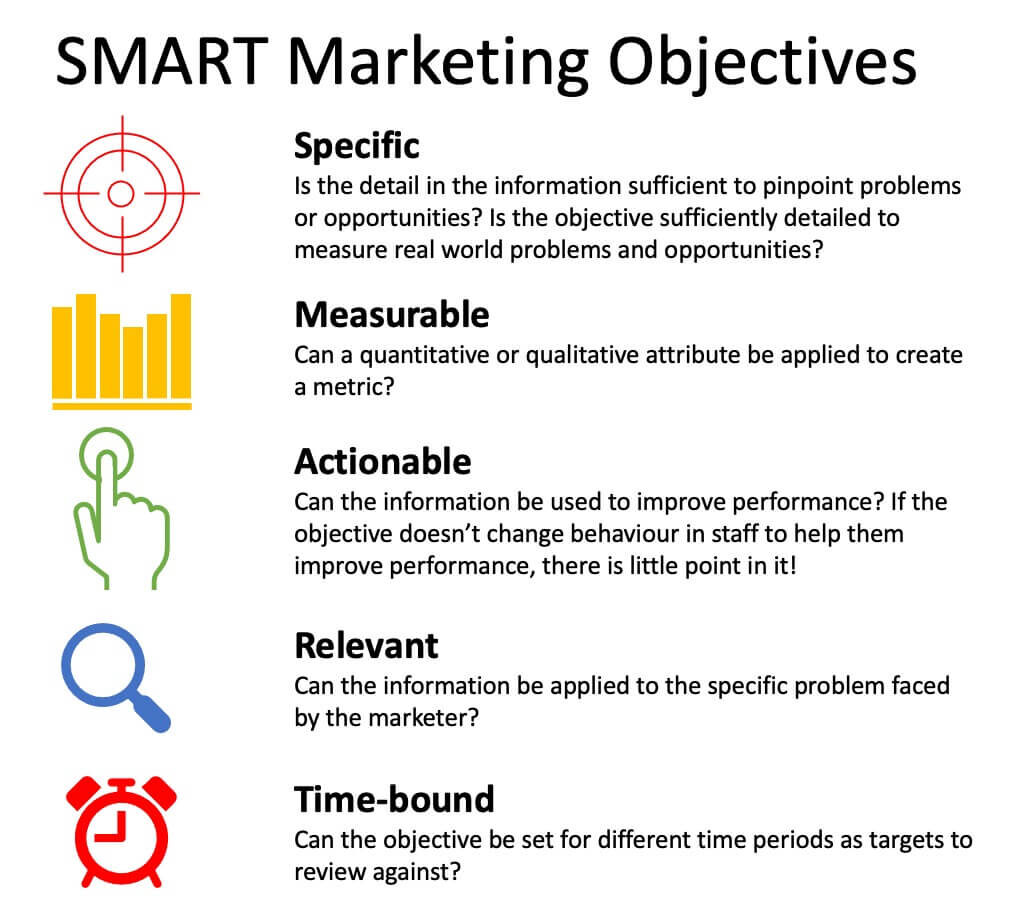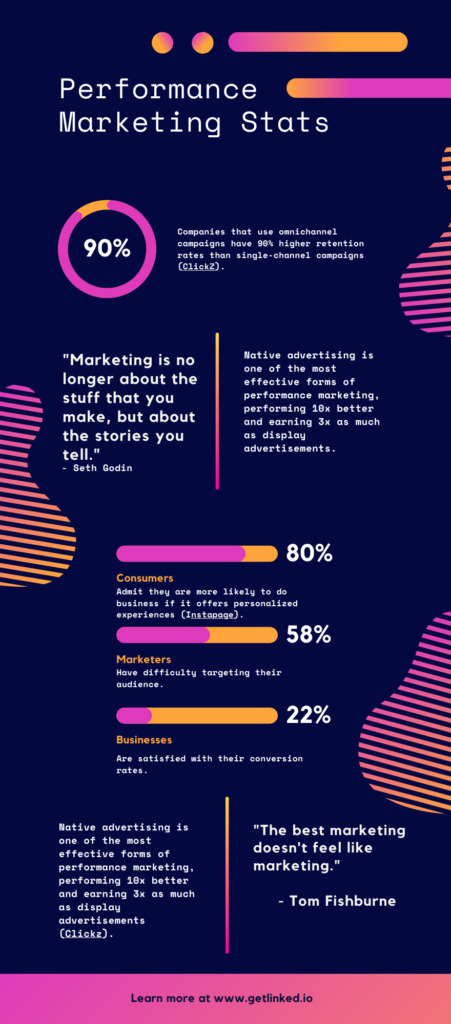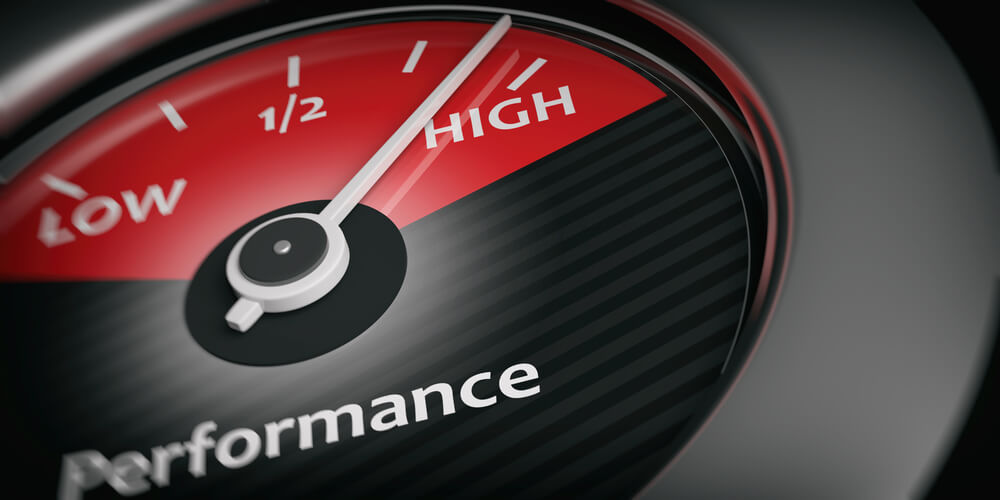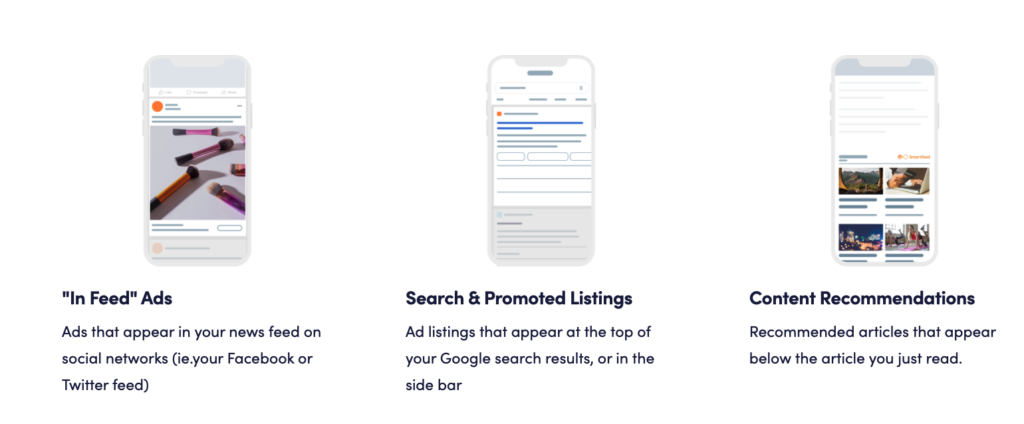Performance marketing is a measurable form of digital marketing that focuses on generating as high a return on marketing investments as possible. Performance marketing branches off into several subfields of digital marketing, such as content, search engine optimization, paid search, and social media marketing. Having a basic understanding of these subfields in respect to performance marketing as a whole is what this publication aims to provide you.
Key Takeaways
- Average industry click-through rates (CTR) vary from 0.46% to 1.9%.
- CPC, CPL, CPA, and CTR are four key performance marketing metrics.
- Native and affiliate marketing are two powerful variations of performance strategy.
- Artificial intelligence, programmatic advertising, and search engine optimization are trending performance marketing innovations.
What is Performance Marketing?
Performance marketing is a form of transactional digital marketing that involves sending leads, clicks, or sales to merchants to complete a specific action. When those actions have been met, affiliates and web publishers are compensated. When combined with affiliate marketing, performance marketing is a publisher’s incentive board, and for affiliates, it’s an opportunity to generate passive income. Now let’s take a look at what components makeup performance marketing.
What is Included in Performance Marketing?
Performance marketing strategy is composed of four parts:
- Publisher – An entity or company that prepares and issues media for sale.
- Audience – A group of people with similar interests you intend to market.
- Message – The purpose behind the campaign (informative, commercial, etc).
- Medium – The intended channels the message will play through.
From there, we can add three additional facets:
- Bid – Programmable factors that allow publishers to determine the date, volume, geographics, and price for building campaigns.
- Trustability – If marketing campaigns fall short, it is often a result of a lack of trust or missing your intended audience.
- Conversions – A core performance metric used to determine the economic feasibility and success of a performance marketing campaign.
Key Performance Marketing Metrics
For the best performance marketing yields, SMART (Specific, Measurable, Achievable, Realistic, and Time-Bound) marketing goals are the key. They provide scope, transparency, and specificity to every marketing campaign and they are vital for optimizing performance marketing campaigns since both are data-driven.

In performance marketing, there are four main types of metrics used to measure the success of campaigns.
- Cost Per Click (CPC) – An amount paid by an advertiser when their advertisement is clicked on.
- Cost Per Lead (CPL) – An amount paid by an advertiser when their advertisement receives a sign-up from interested consumers.
- Click-Through-Rate (CTR) – The ratio of web surfers who click on a specific link.
- Cost Per Acquisition (CPA) – An amount paid by an advertiser when a specific action, like a click, sale, or form submission, occurs.
Click-through rates are one of the most important performance marketing metrics. When your campaigns have a high CTR (+4.0%), you know your campaigns are targeting and engaging the intended audience. Depending on your industry, average click-through rates for search and display ads fluctuate between 0.46% to 1.9%,
Pro Tip: Optimizing emails, images, calls to action, and landing pages is one of the quickest and easiest ways to help beef up your performance marketing metrics.
The 5 Steps of Performance Marketing Campaigns
- Evaluate Goals – Determine an end goal and decide which metrics are needed to gauge success.
- Market Research – Discover which platforms (Facebook, Search, etc) are best to deliver your message and ensure your message flows naturally to your audience.
- Craft Campaigns – Structure content to match user intent.
- Optimization – Using the data from your campaign, make adjustments where needed and narrow down data points, such as device type, time of day, and site type.
- Revisions – Compare the progress of your campaign across two time periods to see campaign procession. For remarketing, consumer data portals like Audiense are often used.
Performance Marketing Types
The following types of marketing approaches are used interchangeably in both performance and digital marketing.
1. Search
Search engine marketing (SEM) is a tried-and-true form of performance marketing that includes search engine optimization and paid search traffic. Given the monumental success of the Google AdWords program, keywords have become the focal point of digital marketing campaigns. While search engine optimization is a highly valuable form of marketing that often drives more long-term engagement and loyalty, paid search tends to generate a faster ROI on marketing campaigns.
2. Social
Social media advertising is comprised of lead generation, engagement, traffic, and sales. Most social networks, such as Facebook, provide measurable and automated KPIs that help advertisers measure the success of their campaigns through CPC, CTR, and overall ROI. To optimize campaigns, remarketing platforms like Audiense can help advertisers better target their intended audience.
3. Native
Native advertising consists of using paid ads that match the feel, vibe, and purpose of their intended media format. Native ads are most commonly recognized in social media feeds or as ‘recommended’ content in a webpage. While native ads are advertisements, they don’t look like advertisements because they flow fluently on the page. The primary ingredient to successful native campaigns includes being non-disruptive.
4. Sponsored
Sponsored content is a branch of native marketing that relies on performance-based content. The most popular form of sponsored advertising includes paid articles that can drive leads, traffic, and conversions from a highly targeted audience while boosting web rankings. Across new portals, sponsored content embodies the form of long-form often since most of their site’s other content is short-form. Last but not least, sponsored content may be informative, commercial, comparative, and transactional.
5. Affiliate
Affiliate marketing can drastically reduce the outreach and marketing demands for companies with valuable products and services. With affiliate marketing, affiliates send traffic to advertisers and receive a commission in exchange for an agreed-upon action, such as a click or a sale. Oftentimes, a native and affiliate marketing approach is used to embedded product links with organic content. As a whole, affiliate marketers operate like independent marketers promoting your brand, services, and values.
At Getlinked.io, we partner with some of the best affiliate marketing networks worldwide. To learn about the advantages we can bring to your online venture, connect with us!
Why Companies Use Performance Marketing?
Entrepreneurs, startup brands, and companies use performance marketing for three main reasons: 1) the industry they operate in is too competitive not to rely on a form of data-driven marketing, 2) marketing campaigns are measurable and returns on investments are easily calculated, and 3) it is an effective marketing approach for tackling multiple company objectives simultaneously (increase brand awareness, improve search rankings, and driving clicks and conversions).
Performance Marketing Trends
The future of performance marketing is evolving and quickly changing. Before the industries become too competitive, it may be beneficial to look into the following performance marketing trends:
- Artificial intelligence – Artificial intelligence marketing is used in fast-paced efforts where speed is of the essence. Advertisers can leverage AI tools to evaluate customer profiles, learn how to best engage and serve them, all while not intervening with the customer.
- Programmatic Advertising – Often resulting in far higher conversions and lower customer acquisition costs, programmatic advertising (like real-time bidding), can help advertisers target more specific audiences. Programmatic advertising was worth $129.1 billion in 2020 (Statista, Global Programmatic Ad spend 2021).
- Search Engine Optimization – Search engine optimization marketing is an exhaustive form of performance marketing but the dividends are often well worth the time, resources, and expenses. Search engine optimization looks to provide raw, valuable content that is structured to rank first on Google, followed by many hours of outreaching, remarketing, and optimization. Search engine optimization can increase companies’ online search visibility, customer base, brand awareness, traffic, and web value.
What’s the ROI on Performance Marketing?
One of the best features regarding performance marketing is that it is a measurable marketing campaign. To determine if your campaigns generated a positive return-on-investment, consider using this simple formula from SmartInsights.
ROI = (Investment Gains – Investment Cost)/(Investment Cost) x 100%
Pros & Cons
Pros
- Improve Brand Awareness
- Measurable, Trackable, & Insightful Stats
- Extend Advertisement Boundaries
Cons
- Heavy Research
- Overpaying for Undelivered Results
- May Waste Already Available Resources
The Final Thought
Performance marketing is the backbone for many corporate marketing departments because it provides a measurable form of campaign success. Scalability is hardly an issue with performance marketing as it is used by entrepreneurs, small businesses, and the largest enterprises. Clicks and conversions are the two main ingredients used to measure marketing engagement while cost per click, cost per lead, and cost per acquisition help gauge ROI.
FAQ
What is the purpose of performance marketing?
Performance marketing aims to increase brand engagement, awareness, and scalability cheaper than other forms of marketing and with better user retainment.
What are performance marketing channels?
- Native Advertising
- Social Media (Influencing) Marketing
- Search Engine (Display Ad)
- Affiliate (Referral)
- Sponsored
How do you measure performance marketing success?
A few key performance marketing factors to measure to determine the success of your campaigns include Impressions, Click-Through Rate (CTR), cost per click (CPC), cost per sales (CPS), cost per leads (CPL), and cost per acquisition (CPA).
How can I get started with managing performance marketing affiliates?
At Getlinked.io, we partner with entrepreneurs, small teams, and enterprises to provide a fully customized performance management system. Our solutions provide scalability, 24/7 support, and intuitive tech-management features you won’t find anywhere else.
What is the future of performance marketing?
Performance marketing will continue to play an important role in developing small businesses and medium-sized enterprises. For powerhouse companies like Amazon, however, they have integrated performance marketing in-house, making it less accessible. All-in-all, performance marketing will likely rise as digital marketing continues to play an increasing role in the day-to-day functionalities of companies worldwide.



